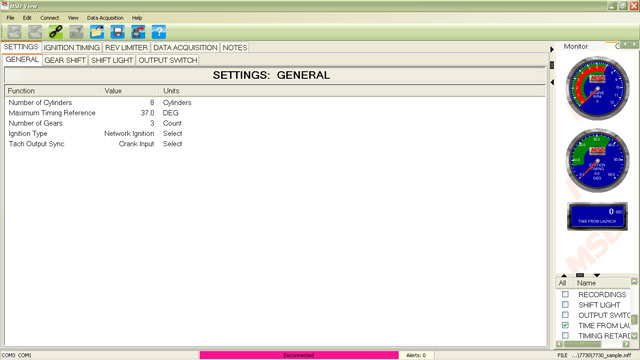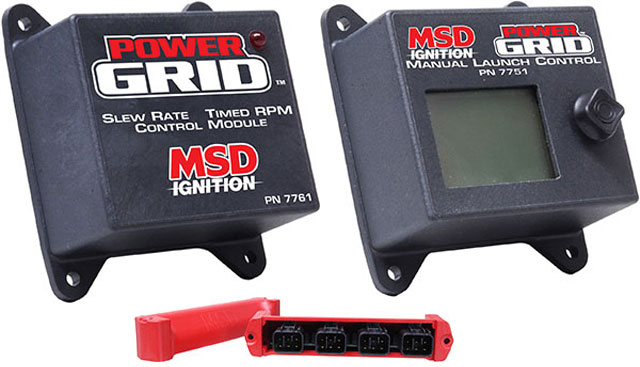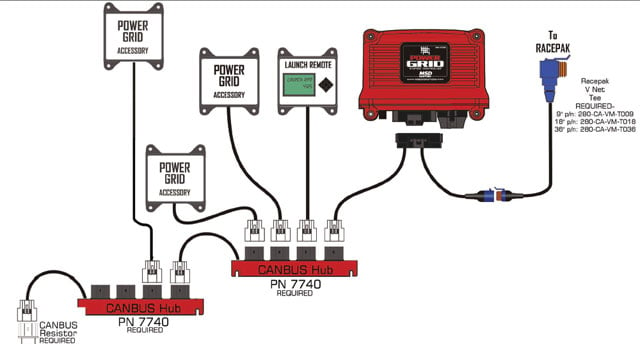For a long time now, MSD Ignition has been making ignition systems for the fastest drag cars on the planet. The latest product from MSD – the Power Grid – is the next evolution of the programmable, 7-series ignition controllers. The system includes two parts; the Power Grid system controller and the Power Grid 7 ignition controller.
Inside the shiny red case of the system controller device is a 32-bit microcontroller, and a new software program called MSD View. The device is also USB compatible with Windows-based software to allow the racer to program the ignition with their computer. The installation process for the Power Grid is simplified as much as possible by MSD, thanks to the CAN-BUS system of wiring that allows for reduced wiring and to permit the addition of accessory modules easily. MSD’s Kyle Neisen said, “The Power Grid ignition system was designed to be as easy to install as possible with accessories that are virtually plug and play; in fact some like the Launch Control accessory are literally plug and play.”

The Power Grid works best with the new Power Grid 7 ignition controller. Both electronics hook directly to each other and can even be bolted together.
The 7531 works so well, then why the Power Grid?
One of the burning questions in our mind when the Power Grid system turned up was – why. MSD already has one of the most popular and successful programmable ignition systems in drag racing with its 7531 system. So why come out with a new system that will sit above an ignition that has been so successful? Neisen gave us a bit of insight on that, “We came out with the Power Grid to supersede the programmable 7 units because we knew we could make it a better. The goal was really ultimate timing control that would work for anyone that needed it. Even though the 7531 still sell well, we knew we could improve, so we did.”
Something else that racers will appreciate with the new Power Grid system is that MSD says the modular design of the Power Grid means the company doesn’t have to start over with a new ignition system each time it want to make changes. Neisen said, “With the new modular system, we won’t have to make an all new box every time we get a new idea. We can either send out a software update that allows it or design a new module to plug into the system if hardware is needed. That saves racers money and helps us roll out new features more quickly”
The brains of the system is the Power Grid controller (PN 7730) and it will work with all MSD ignitions, including the Pro Mag. However, it was designed specifically to work with the new MSD Grid-7 ignition (PN 7720). This particular ignition has a higher output than other current programmable units on the market today. When you purchase the Power Grid controller, it will come with the hardware needed to mount it and get things started. Included is the View Software, wiring harness, microSD card, and the mounting hardware. The ignition is sold separately.
The specifications of the system are as follows:
• Spark energy of 200-220mJ per spark
• The primary voltage is 545-570 volts
• The secondary voltage is 50,000 volts plus
• The spark series duration is 20-degrees crankshaft rotation
• RPM range is 15,000 RPM with 14.4 volts
• Required voltage is 12-18 volts with negative ground
• Current draw is 1.3 amp per 1,000 rpm
• The box weighs 2.9 pounds and measures 7.5″ L x 5″ W x 2.25″ H
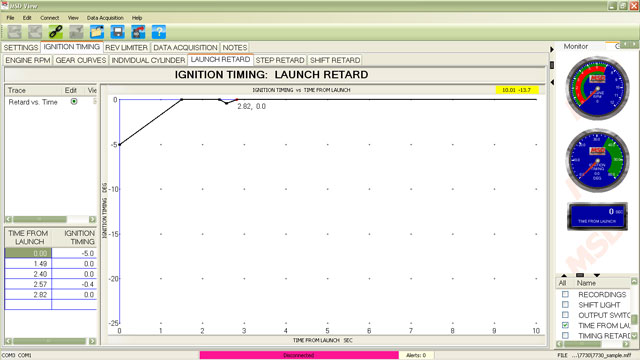
The launch retard can be triggered of a trans-brake button to aid with power delivery during launch.
The Power Grid has some impressive programming features, and the USB connectivity is what makes tuning so easy. The racer only needs to plug in a Windows laptop and they are ready to program. The programming features allow the timing to be changed based on the engine RPM and gear value. Timing can also be advanced on each individual cylinder based on timing or gear. There are five different retard stages for racers running nitrous, and you can dial in four steps of RPM limits with settings for burnout, spool, launch, and overrev. Shift light settings can also be set for each gear, and the ignition data acquisition accepts multiple runs. The Power Grid controller alone sells for $407.10 at the time of writing.
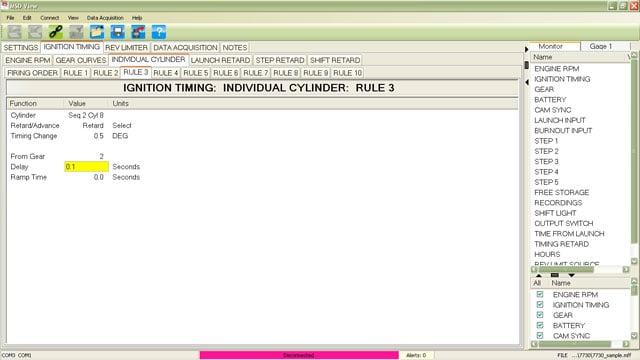
Ignition timing can be controlled on a per cylinder basis, allowing for a leaner cylinder to run a different timing curve than the rest.
The Power Grid system Controller and the Power Grid 7 Ignition control are the two main components of the system. There are several other accessories that can be used as well that were briefly mentioned before. Those planning to use any of the accessory boxes for their Power Grid system must buy the 4-port CAN-BUS Hub. It is required to connect any accessories to the 7730 system controller. As more accessories for the system are needed and are launched by MSD, the 4-Connector CAN-BUS hubs can be stacked for unlimited numbers of accessories.
Another key component to the Power Grid system and its accessories is the MSD View Connect software. MSD offers a free download of the software with a sample file to allow racers to play with the software and see how easy it is to use and program. The software allows racers and pit crews to import data from previous runs so that the RPM settings can be checked allowing a look at historical data to see what worked and what needs to be changed. Neisen said, “The Power Grid system using the MSD View Connect software provides the simplest tuning that MSD has ever offered.”
The cool part about this data is that points on the graph can be plotted to perform actions, like not allow the engine to hit overrev if the tires lose traction a second into the run. That will help stop the tires from spinning and allow the vehicle to get traction and finish a run. “The MSD View Connect Software is very intuitive. You don’t need to be a computer expert to program a computer-controlled ignition system,” said Neisen.
Power Grid Options
The Power Grid has several modules that are available as accessories. MSD says that more modules will be coming, but right now available accessory modules include a Slew Rate and Time Based Rev Limiter Module (PN 7761), a manual launch control (PN 7751), and a 4-connector CAN-BUS Hub (PN 7769).
The 7751 Launch Control Module for the Power Grid system is a little black box that allows the racer to use a 2-step style rev limiter. The module will take over the racer’s shift light prior to launch. The module is easy to use and will allow for fast and easy changes to launch RPM, light intensity, or launch light windows from right within the cockpit. The 7751 requires the use of the 4-connector CAN-BUS Hub to attach to the Power Grid system controller and the 7751 can’t be used without the system controller.
The other accessory available right now is the Slew Rate and Time Based Rev Limiter module 7761. This module can set the RPM limit based on slew rate (RPM acceleration) or based on the time since the vehicle launched. The limits of the system can be programmed in the MSD View Software. This accessory must be connected to the CAN-BUS Hub as well to operate with the Power Grid system. If you are the sort of racer that loves to view the data obtained from an acquisition system during your runs, the Power Grid system can be connected to your Racepak via the V-Net technology plug on the Power Grid controller. That allows the Racepak to grab all the data you want with a very simple hook up to the Racepak with the V-Net connector.
MSD’s latest Power Grid ignition system and its accessories sound like a very serious bit of kit for racers out there, and I would bet more than a few drivers will turn in some impressive ETs using this system. The Power Grid ignition system from MSD will be a very interesting option for the racer looking for a computer-controlled ignition that has a lot of tunability, without all the complexity and hassle that often comes with lots of flexibility.
Combine the robust software interface with the ease of use and MSD’s new Power Grid system and accessories will be a force to be reckoned with at the track. The Power Grid system will allow the racer to spend less time in the pits fighting a complex programming interface and more time on the track racing.
All that the racer with a Power Grid system installed will need to do when new features are added or an upgrade is needed to their Power Grid is upload a software update to the box or add a module. That means no more replacing your expensive ignition system simply to get a new feature you really want. The modular design of the Power Grid may make this the last ignition system a racer has to buy that is updatable as long as MSD supports it. If you use Power Grid, be sure and let us know what you think in the comments.




